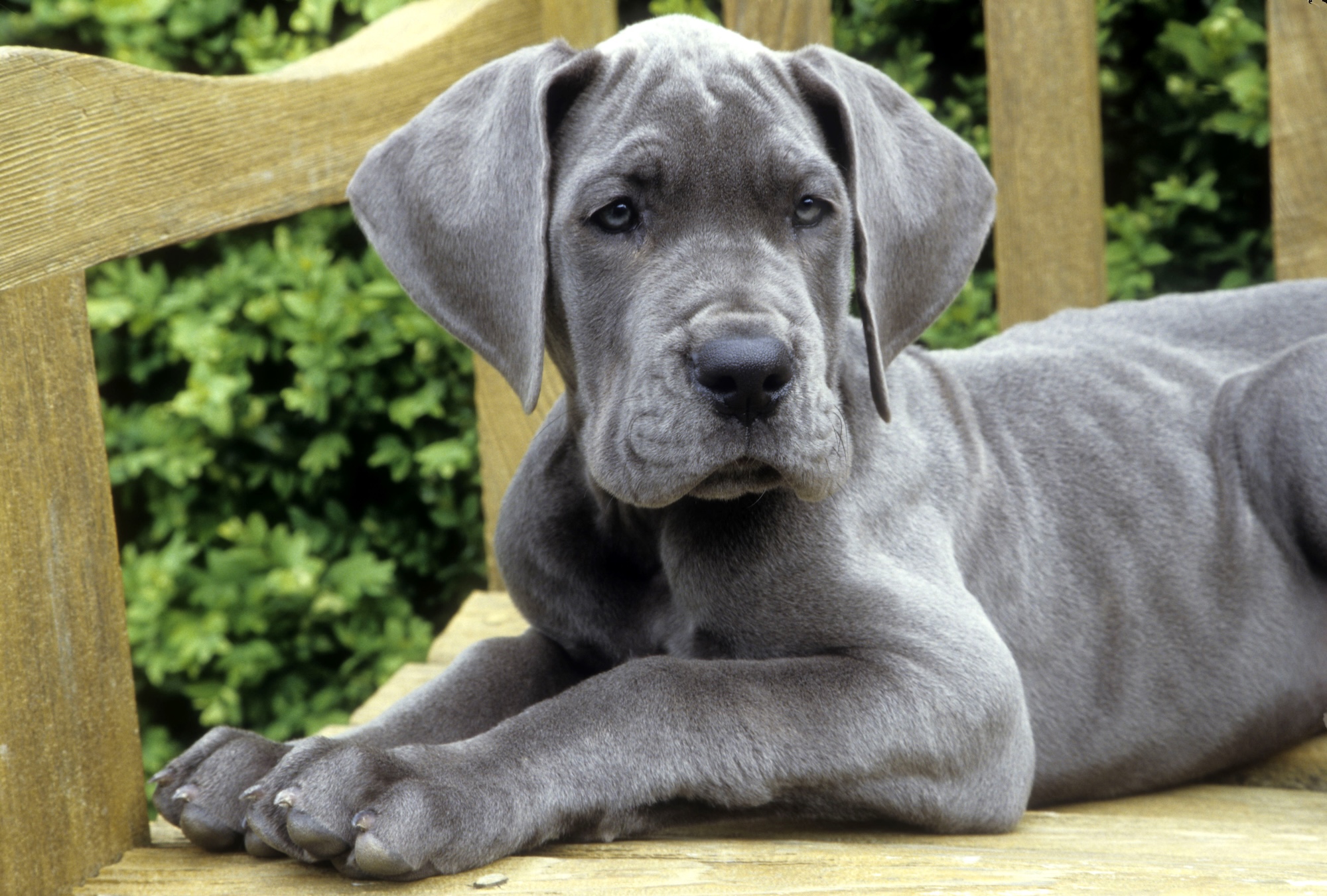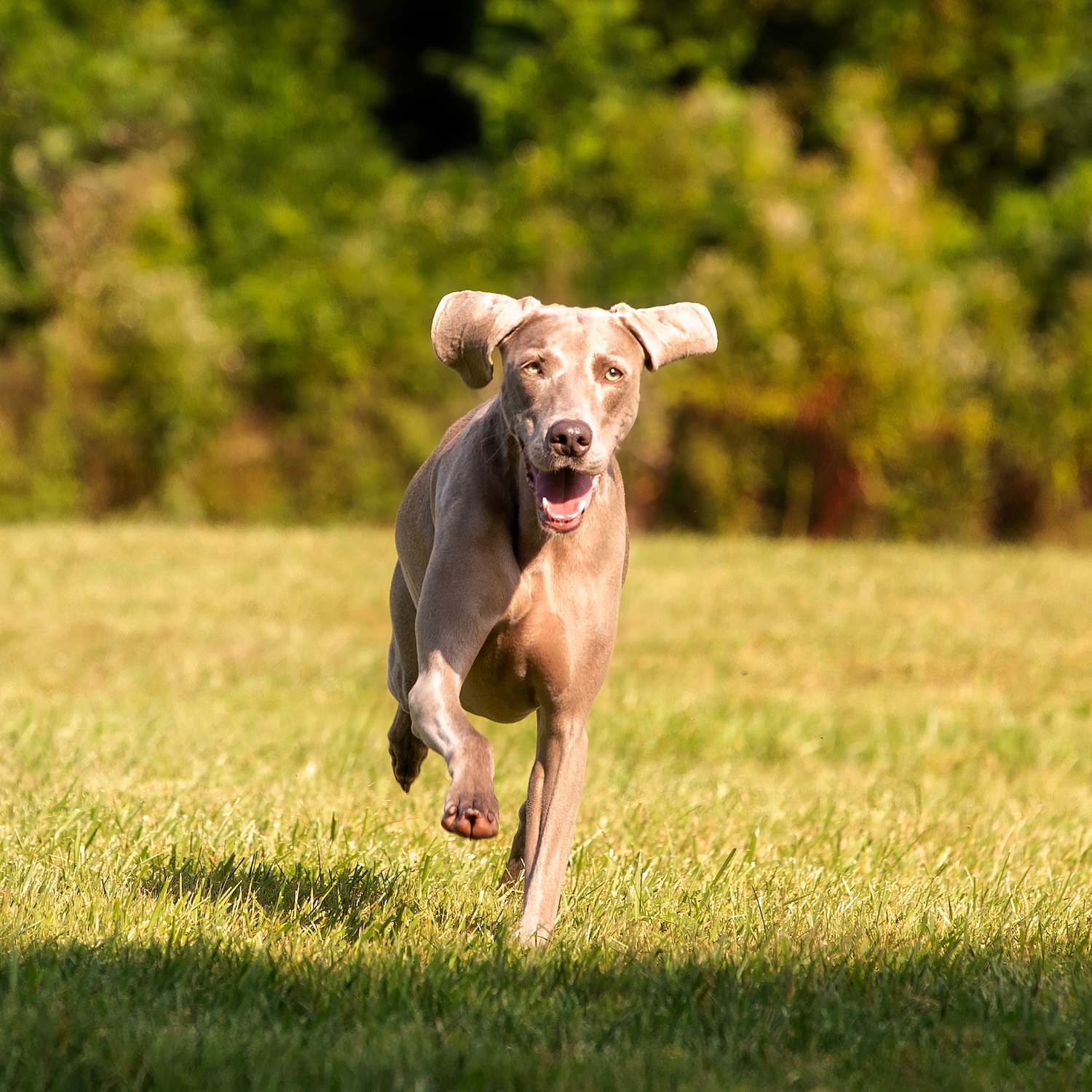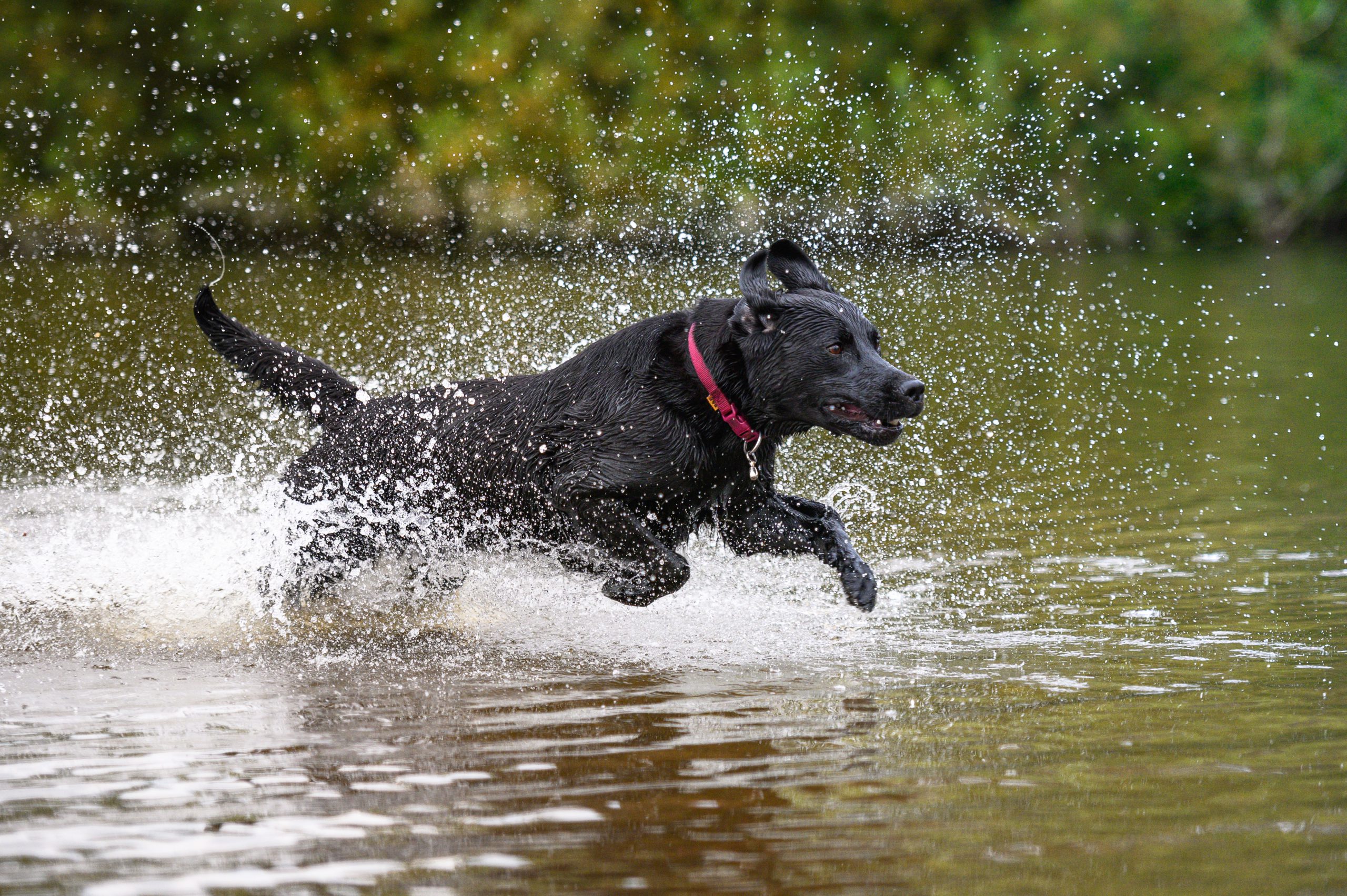Whether chasing after a tennis ball or heading into the woods for a long hike, the Rhodesian ridgeback is a born athlete. These dogs have ample energy to burn, so they’re perfect for active individuals and families who love the great outdoors and have plenty of time to devote to training. They’re also highly affectionate, and form strong bonds with their human family members.
If you’re considering bringing a Rhodesian ridgeback into your family, or if you want to take better care of the one you’re petting right now, here’s what you need to know.
Basic Rhodesian ridgeback breed facts
Originally developed in Southern Africa, the Rhodesian ridgeback is a large-breed dog with a muscular build. The breed’s name is a nod to its African origins and its most distinctive physical feature—the ridge of fur in the middle of its back.
Though once bred to assist in the hunting of lions, ridgebacks today are known as affectionate and fiercely loyal family dogs. Due to their strong wills and even stronger bodies, they’re best for experienced dog owners who can provide a foundation of early socialization and training.
According to the American Kennel Club (AKC), mature Rhodesian ridgebacks typically weigh between 70 and 85 pounds and stand an average of 24 to 27 inches tall.
The breed comes in one color, wheaten, which ranges from pale brown to deep reddish brown. ridgebacks have short, glossy coats which are uniform in length over the entire body—except for the trademark ridge of backwards-growing fur along their spines.
“Buff thinks he is a lap dog. [He’s] loving [and] amenable to other dogs—and loves people, especially small children. His only problem is size, as he leans on those who pet his backside and loves to lick faces.” –Alan, Buff’s person

Rhodesian ridgeback breed history
The Rhodesian ridgeback’s origins trace all the way back to the 17th century.
Forebears of the modern Rhodesian ridgeback were semi-domesticated hunting dogs kept by the Khoihkoi people, a nomadic tribe indigenous to South Africa. When Dutch traders arrived in the middle of the 17th century, they described the dogs as fearless guardians. It’s no surprise, then, that European colonists quickly began using these dogs themselves.
Throughout the 1800s, Europeans introduced other hunting breeds—like Bloodhounds, greyhounds, and mastiffs—into the gene pool of indigenous African dogs.
A 2020 study found that the great Dane was another major contributor to the development of the early Rhodesian ridgeback. This analysis, which sequenced 27 ancient dog genomes, also showed that modern Rhodesian ridgebacks retain 4% precolonial ancestry.
Today’s Rhodesian ridgebacks maintain the intelligence and athleticism of their ancestors—but, rather than on the hunt for big game, you’re more likely to find them keeping humans company as beloved family members.
“I know I’m biased, but to me he’s majestic—such a good-looking boy. He is very goofy, skittish, and stubborn. His head tilt is the cutest.” –Tammy, Jake’s person
Rhodesian ridgeback personality
First, a reminder: Every dog is an individual—so, while people who’ve spent time with Rhodesian ridgebacks may have noticed trends, you can’t assume that any single member of the breed will have a certain personality. If your Rhodesian ridgeback behaves differently than you might expect them to, that’s not a defect—it’s just the way they are. Get to know the dog you have, and care for them accordingly.
Rhodesian ridgebacks are known for being gentle, affectionate, and dignified. They bond deeply with their human companions. But to keep them happy and well-behaved, you must devote yourself to giving them proper training and exercise—physical and mental.
When properly trained, a Rhodesian ridgeback can excel as a family pet, hunting partner, show dog, or obedience competitor. The flip side of this is that, while Rhodesian ridgebacks are highly trainable, they—and you—are likely to suffer if you don’t give them enough physical and mental activity. If you don’t give your Rhodesian ridgeback something interesting to do, they may engage in behaviors that you find undesirable. Like people, dogs can get bored—make sure that you fulfill your Rhodesian ridgeback’s needs and give them constructive outlets for their talents.
It’s also important to remember the breed’s high prey drive. Even a well-trained Rhodesian ridgeback should be kept on-leash in any open area, lest they chase after a sight or smell that catches their attention.
Ridgebacks can get along with other dogs or cats, especially when they’re raised together from a young age. But exercise caution when introducing them to unfamiliar animals; don’t leave them alone with other pets unless you’re sure they get along, and don’t hesitate to consult a qualified trainer for further advice on the matter. Like many dogs, Rhodesian ridgebacks—even those who love their families—may be more reserved around strangers. That’s one reason that early socialization is essential.
“Roxie plays with every toy that has been given to her. She’s a great playmate!” –Jeri, Roxie’s person

Rhodesian ridgeback training and exercise
All dogs require training, but early socialization paired with a solid foundation of training is particularly important for this breed.
Here are some specific considerations for training Rhodesian ridgebacks:
Obedience training: Getting a handle on basic skills is a must—”sit,” “stay,” and “wait” will be your friends over the years, as will reliable recall. Train your puppy early, and reinforce training throughout their life. Don’t forget leash training, as these muscular dogs can be strong pullers.
Impulse control: Take the time to learn your dog’s individual temperament and triggers so you can anticipate them. Teaching commands like “leave it” can be particularly useful.
Avoid punishment: Rhodesian ridgebacks are smart, and can become very in-tune with human emotions. Control your temper during training, and reward the behaviors you want. If you do this, your ridgeback is more likely to want to do what you ask of them—including coming when called—and be confident that doing so will get them good results.
Patience is key with a Rhodesian ridgeback. Even with all the training in the world, your dog is going to follow their instincts sometimes. Do everything you can to keep them safe by walking them on a leash and making sure your yard is properly fenced.
Lindsay Parenti, a Certified Professional Dog Trainer (CPDT) and the owner of Dr. Woof Animal Behavior Consulting, describes the ideal Rhodesian ridgeback owner as someone who can “spend plenty of time ensuring their dog gets enough physical and mental stimulation.” Exercise will help your ridgeback work off excess energy—it also provides mental stimulation to help curb the boredom that often leads to destructive behavior. An adult may need as much as an hour and a half of moderate-intensity exercise a day. If you want to meet your dog’s need for exercise and mental stimulation at the same time, try dog sports like lure coursing or agility.
“He runs extremely fast, at times almost comically out of control. He loves to cuddle and, [despite] his size, sit in your lap.” –Suzanne, person to Milo, a ridgeback/pit bull mix
Rhodesian ridgeback grooming
Rhodesian ridgebacks are short-haired, and don’t shed too much—but, like any dog, they require some grooming and bathing from their humans. Unless they get very dirty or have a specific condition, you shouldn’t bathe them more than monthly.
Pay close attention to your Rhodesian ridgeback’s nails. You don’t want them to get too long. Find a trimming or filing method that’s comfortable for you and them—don’t force them into a scary claw-clipping situation if they don’t want to do it. Instead, gradually acclimate them to the tools through positive reinforcement, and consult with your vet about the safest trimming method that will avoid cutting their quicks. Filing or using a Dremel is also an option, and regular walks on harder surfaces can help wear down their claws.
Common Rhodesian ridgeback health concerns
Healthy Rhodesian ridgebacks typically live 10 to 12 years—but they are predisposed to certain conditions that can impact their lifespan and quality of life. These include:
Dermoid sinus: One of the most common inherited health problems in Rhodesian ridgebacks, dermoid sinus is also known as pilonidal sinus. It’s a tube-like opening in the skin that develops as a birth defect. These defects are usually found on the neck, back, or upper spine and can be treated surgically.
Joint dysplasia: Like many large and active breeds, the Rhodesian ridgeback has an increased risk of joint issues—particularly hip and elbow dysplasia. Dysplasia is a condition in which the joints dislocate. Over time, it can lead to chronic pain and arthritis. Weight maintenance is a key element in preventing joint issues in Ridgebacks. Also be sure to feed them to maintain proper growth, especially in puppyhood, and only give them an appropriate amount of exercise as they grow. Consult your veterinarian for details.
Food allergies or sensitivities: Rhodesian ridgebacks are predisposed to allergies triggered by certain foods—usually specific proteins. Untreated allergies can lead to atopic dermatitis, or itchy skin. Switching the dog to a high-quality diet free from the ingredient they’re allergic to generally helps resolve symptoms.
Hypothyroidism: In dogs with this condition, the thyroid gland doesn’t produce enough thyroid hormone. This can lead to skin problems, low energy levels, and weight gain.
Juvenile myoclonic epilepsy: A seizure disorder that typically develops around six months of age, this form of epilepsy causes seizures—usually in the front half of the dog’s body, and usually when they’re relaxed or falling asleep. The condition can be managed with medication.
If you’re getting a puppy, make sure their parents have been screened for common issues. It may not be possible to know an adopted dog’s medical history, but you can and should ask the rescue organization or shelter questions about the dog’s health and behavior. And regular vet visits can help you stay on top of any dog’s health.

Feeding your Rhodesian ridgeback
As with any breed of dog, it’s important to feed Rhodesian ridgebacks healthy, complete and balanced food on a regular schedule. Here are some other important considerations:
Watch their weight: Extra weight puts added stress on a dog’s heart and joints, and is linked with an array of health conditions, so it’s important to determine the appropriate calorie intake while ensuring proper nutrition. One way to improve your dog’s chances of continued good health is to keep them in an ideal body condition. A fresh-food plan makes it easy to feed the right amount for their age, size, and activity level.
Limit treats and snacks: Treats and snacks should make up no more than 10% of your dog’s daily calorie intake. They make great training rewards, but don’t go overboard on the quantity.
Support joint health: A fresh diet that provides balanced omega-3 fatty acids may help keep joints healthy. A pre-portioned fresh food plan also makes it easy to feed the right number of calories every day. This helps maintain a healthy weight, which is another key factor in keeping joints healthy, as well as improving general health and quality of life.
Mind those teeth: Eating for dental health means eating for overall health–a fresh, whole-food diet promotes a healthier immune system, which helps ward off dental maladies. Crunchy kibble is often said to clean teeth, but most kibble does no such thing. In fact, kibble is an ultra-processed food, and as such can contain substances that actually fuel inflammation in the body, including the tissues of the mouth.
A healthy diet—alongside training, exercise, vet care, and lots of quality time—is among the keys to helping your Rhodesian ridgeback live a happy, healthy life.
Where to get a Rhodesian ridgeback
If you’ve decided that a Rhodesian ridgeback is right for you, consider adopting one from a local rescue or animal shelter. One option is Rhodesian Ridgeback Rescue, Inc., the official rescue program of the Rhodesian Ridgeback Club of the United States.




